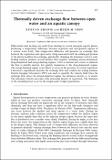Thermally driven exchange flow between open water and an aquatic canopy
Author(s)
Nepf, Heidi; Zhang, Xueyan
DownloadNepf_Thermally driven.pdf (275.2Kb)
PUBLISHER_POLICY
Publisher Policy
Article is made available in accordance with the publisher's policy and may be subject to US copyright law. Please refer to the publisher's site for terms of use.
Terms of use
Metadata
Show full item recordAbstract
Differential solar heating can result from shading by rooted emergent aquatic plants, producing a temperature difference between vegetated and unvegetated regions of a surface water body. This temperature difference will promote an exchange flow between the vegetation and open water. Drag associated with the submerged portion of the plants modifies this exchange, specifically, changing the dominant velocity scale. Scaling analysis predicts several distinct flow regimes, including inertia-dominated, drag-dominated and energy-limiting regimes. After a constant heat source is initiated, the flow is initially inertial, but quickly transitions to the drag-dominated regime. The energy-limiting regime is not likely to occur in the presence of rooted vegetation. Laboratory experiments describe the exchange flow and confirm the scaling analysis. Particle Imaging Velocimetry (PIV) was used to quantify the velocity field. Once the exchange flow enters the drag-dominated regime, the intrusion velocity uV is steady. The intrusion velocity decreases with increasing density of vegetation. The thickness of the intruding layer is set by the length scale of light penetration.
Date issued
2009Department
Massachusetts Institute of Technology. Department of Civil and Environmental EngineeringJournal
Journal of Fluid Mechanics
Publisher
Cambridge University Press
Citation
Zhang, Xueyan, and Heidi M. Nepf. “Thermally driven exchange flow between open water and an aquatic canopy.” Journal of Fluid Mechanics 632 (2009): 227. © Cambridge University Press 2009
Version: Final published version
ISSN
0022-1120